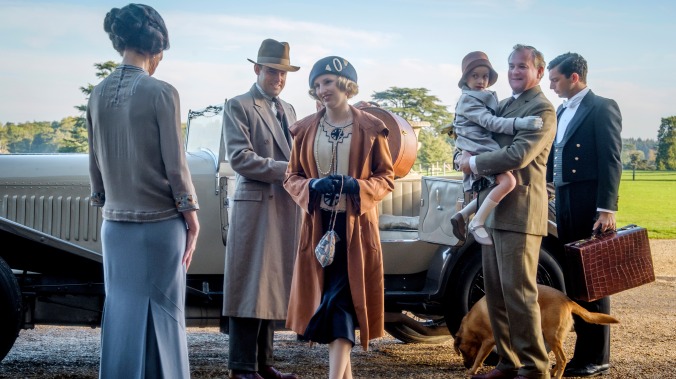The Downton Abbey movie is as pleasant as a cozy cup of tea

In retrospect, it’s clear that writer-creator Julian Fellowes already had his sights set on a reunion when he capped off the phenomenally popular six-season run of his ITV/PBS period drama, Downton Abbey. (The actors have even said as much.) While the series finale offered a sense of finality for the aristocratic Crawley family and their loyal servants, Fellowes made sure to leave some doors open for future stories as well. Four years later, the highly anticipated feature film follow-up attempts to strike that same balance. It provides a glamorously royal justification for the series’ leap from the small screen to the big one, but it’s equally concerned with laying groundwork for potential sequels. Not as blatant as the worst franchise-baiting cliffhangers, it’s nevertheless cagey about definitively resolving many of its storylines, to the point where it’s largely missing a third act—which, admittedly, probably won’t matter too much for fans who have been longing to return to this stylish world. The big-screen version of Downton Abbey is still engaging, well-dressed comfort food. It just doesn’t quite feel like a full meal.
The film opens in 1927, less than two years after the series left off—not that you’d know it based on how curiously quickly some of the kids seem to have aged. Lord Grantham (Hugh Bonneville) and his wife, Cora (Elizabeth McGovern), receive a letter informing them the king and queen (Simon Jones and Geraldine James) are coming to Downton Abbey as part of their tour of Yorkshire. The one-night stay sends the entire household into a tizzy, both upstairs and down. Everyone is determined to get the high-stakes visit right, from icily glam eldest daughter Lady Mary (Michelle Dockery) to bumbling footman Joseph Molesley (Kevin Doyle, a comedic scene-stealer). It’s a setup that never quite gives way to an actual plot. The episodic storytelling includes an action-packed parade, a high-stakes royal dinner, and a lavish ball, but there’s no spine to tie it all together nor a real finale to wrap it all up. The film feels simultaneously like an episode stretched to feature length and half a season without a conclusion.
Still, apart from a tonally misjudged, hijinks-heavy comedic subplot about the Downton staff fighting back against the snooty royal servants who temporarily displace them, the Downton Abbey film largely recaptures the amiable spirit of the show. Nearly every major character save Lily James’ Lady Rose is back, and there’s a nostalgic rush at seeing them all together again. Though Downton’s unfettered love for the 1% has never felt more boldly out of touch with the contemporary moment—the most villainous character Fellowes can imagine is a servant who dares to question whether the aristocracy deserves the privilege it was born into—the ensemble is as funny and charming as ever. As she did on the series, Maggie Smith’s Dowager Countess steals the show with an endless stream of pithy one-liners, and some appreciable emotional pathos, too. Scheming-footman-turned-kinder-butler Thomas Barrow (Robert James-Collier) gets a subplot about gay life in the 1920s that’s so compelling you almost wish the whole movie were about it.
There’s not too much handholding for the uninitiated, although the film does simplify some of the status quo of the series finale to make it easier to follow along. (The palsy that drove Jim Carter’s Mr. Carson to retire goes curiously unmentioned as the loyal butler returns to serve the king and queen.) Yet, throwing its audience into the aristocratic deep end is also par for the course for Downton. New viewers would be forgiven for assuming Princess Mary (Kate Phillips) must have been an important character on the series, given how much time is devoted to her domestic ennui. But, nope, she’s a new addition, as are Lady Maud Bagshaw (Imelda Staunton), a cousin who’s locked in a battle over inheritance with the Dowager Countess, and her gentle maid, Lucy Smith (Tuppence Middleton), who catches the eye of Lord Grantham’s widowed son-in-law Tom Branson (Allen Leech). The new upstairs characters fare better than the cartoonish downstairs ones, who include David Haig as the snobbish royal butler. In either case, however, it’s a little frustrating that major players from the series are slighted in favor of new additions. (Bonneville and McGovern are underserved, while Penelope Wilton at least gets to shine as sensible Cousin Isobel.)
Having helmed several episodes of the show, including the finale, director Michael Engler largely maintains the look of the series, adding some helicopter and drone shots to show off the geography of the Downton estate in a way the TV show never could. There are moments where the glossy cinematography doesn’t entirely jibe with the period setting, but costume designer Anna Robbins helps make up the difference with some absolutely gorgeous late-’20s ball gowns, particularly for Lady Mary and her marchioness sister, Edith (Laura Carmichael)—who gets an exhilarating subplot about a dress she ordered arriving in the wrong size. Golly! While the film never reaches the rich dramatic highs that defined the series at its best, it serves as a largely effective test run for what could be a whole new era of big-screen Downton storytelling. Gentler, sillier, and a bit more aimless than an average episode, the Downton Abbey film isn’t great art. It doesn’t even entirely feel like a complete movie. But for fans who’ve been missing the show’s rosy depiction of the past, it’ll provide a lovely afternoon at the theater.